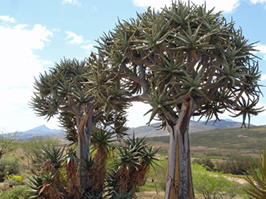Africa: All of a Quiver
15.12.09
 Many plant species around the world are threatened by a changing climate. But, topping the list, according to IUCN, is the Quiver Tree (Aloe dichotoma) of southern Africa.
Many plant species around the world are threatened by a changing climate. But, topping the list, according to IUCN, is the Quiver Tree (Aloe dichotoma) of southern Africa.
This beautiful plant is one of the most distinctive elements of the flora in the Northern Cape and Namibia, where it rises from the scrub and desert on ancient trunks with an unmistakeable crown of leaves. It takes its name because the native San Bushmen used the dead hollow trunks as quivers for their arrows. Apparently dead trunks are also used as natural fridges; as the fibrous tissues cools the air as it passes through it, making it a useful storage space for meat, vegetables, and water.
But it is the ecology of the plant that makes it so susceptible to climate change: it’s slow-growing, long-lived (over 300 years), and its seeds don’t travel far. “The Quiver Tree is noted for its drought tolerance and longevity, but in fact, like other desert organisms it may be operating at the edge of its physiological tolerance,” says Wendy Foden of IUCN’s Southern African Plant Specialist Group.
Iconic Quiver Trees in Namibia are threatened by a changing climate
The rapidly changing climate in Africa means Quiver Trees are slowly losing the populations on the equatorial limit of their range, while by contrast the plants are flourishing pole-wards. However, IUCN report that no new populations have been found in their pole-wards range and worry that eventually the climate will overtake the plants leaving isolated populations, with no recruitment, to simply die out.
This situation is symptomatic of slow-moving plants, so scientists are debating whether the plants should be helped along the way by planting new populations in the more hospitable southern end of their range. This process of “assisted colonisation” has been widely debated by ecologists, climate scientists and conservationists for years, but as yet has no clear outcome. It’s probably about time we get to the bottom of this issue as it seemingly has a vital part to play in the adaptation of ecosystems to climate change.
Genes, genes, genes
Ironically it is in the northern limit of the range – where the populations are fading – that most of the genetic diversity of the species is found. It also contains the populations that are best adapted to a very hot and dry climate. Given that this climate pattern is spreading southwards there will come a time when conservationists will have to agree on a strategy to save this icon of the region. Do they “risk” genetic pollution by trans-locating better adapted plants from the drier north, or do they trust in the agility of the more genetically-restricted southern populations to adapt?
Related links:
Download the full IUCN report
Over 12,000 plants on the Red List
03.10.09
It’s that dreaded time of year again - the time when it is spelled out so clearly how badly we are failing the planet. The latest update of the IUCN Red List of Threatened Species shows that 17,291 species out of the 47,677 assessed species are threatened with extinction. Of these a staggering 12,151 are plants - up 96 on last year - but it’s almost guaranteed they will get less publicity than their furry friends.